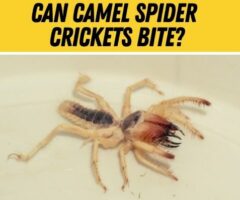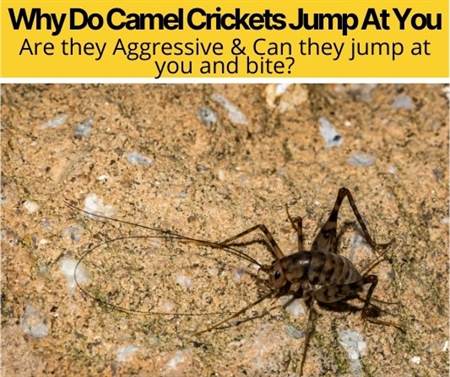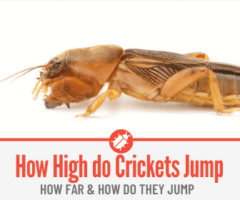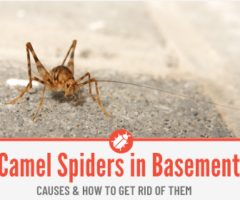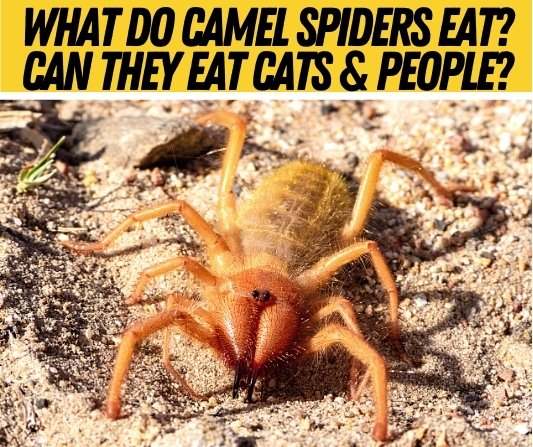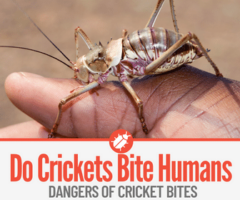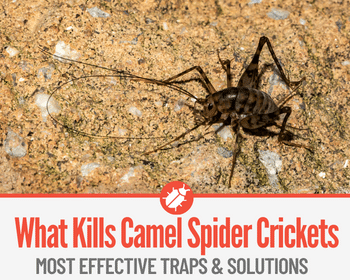 If you’ve seen something in your home that looks like a cricket and a spider had a baby, don’t panic.
If you’ve seen something in your home that looks like a cricket and a spider had a baby, don’t panic.
Camel spider crickets (also known as spider crickets, camel crickets, cave crickets, or sprickets—these are all the same species of cricket simply known by many names) aren’t dangerous to you, but they may cause damage to your home.
Read on below to learn how to trap, kill, and exterminate a camel spider cricket infestation in your home.
Common Items That Can Be Used to Kill Camel Spider Crickets
There are things around your house or easily available in stores that can be used to kill spider crickets.
In all instances, make sure you take proper precautions and follow instructions. Be aware of your safety, and the safety of your family and your pets.
1.Diatomaceous Earth
Diatomaceous earth is a type of sedimentary rock that has been ground into a fine powder. It’s actually composed largely of the fossils of tiny creatures called diatoms.
It’s a great alternative to borax or boric acid to kill Spider Crickets, because it is non-toxic but just as low-maintenance to use.
Simply scatter diatomaceous earth around baseboards and cracks in walls, and places where you find camel spider crickets.
As the pests move through the powder, it scratches up their exoskeletons so badly that the damage causes them to die.
After a few weeks, vacuum up the powder and the dead sprickets.
2.Essential Oils
There are some oils that can be used to kill camel spider crickets. Cedar oil dehydrates them and neem oil makes them stop eating and drinking.
You can also make a spray using a cup of water, a quarter cup of white vinegar, and ten drops of peppermint oil.
Use the spray to either spray on the Spider crickets or in places such as basements where camel spider crickets like to hide.
3.Raid Bug Spray
Raid, or other indoor bug sprays, are made specifically for killing insects in your home and can work great to get rid of Camel crickets.
When using any bug spray, follow all directions.
For Raid specifically, to kill crawling indoor pests like camel spider crickets, you should:
- Spray places where the camel crickets live such as around the perimeter of your basement, near baseboards, undersides of cabinets and other storage areas, behind bookcases and any other openings where they can hide.
- Make sure to Spray from a distance of around 15-20 inches to hit as many Camel spider crickets as possible.
- To get rid of camel crickets in kitchens, also spray behind refrigerators, stoves and open storage areas.
- When spraying by gas stoves or water heaters, make sure the pilot light is first turned off as Raid is highly flammable.
When it comes to Raid bug spray, Keep it out of reach of children and pets.
4.Bifen IT
Bifen IT is another insecticide that is effective against camel spider crickets, among other pests.
As with Raid, be sure to read the directions thoroughly and follow them carefully when using this product as it’s a very potent insecticide
5.Bug Bomb / Fogger
A bug bomb, also known as a fogger, works by spraying a mist of pesticides into the air to settle on surfaces in an area.
The big appeal of a fogger is that it is a good option for camel spider infestation that is large and harder to control with the previously mentioned methods.
The drawback is that they require more care to prepare to use them, and more cleanup afterwards.
As with all potentially dangerous products, read the instructions before use and for cleaning afterwards when using bug bombs to kill camel spider crickets.
Generally, though, expect to be taking something similar to the following steps:
- Before using a bug bomb on camel spiders, remove, put away, or cover anything you don’t want to encounter the pesticides (children’s toys, pet beds, etc).
- Unplug electronic devices to prevent risk of fire; make sure you plan how to set off the bug bombs and leave quickly.
- While the bug bomb is working on the spider crickets, keep yourself, your family, and your pets out of the house.
- Following the evacuation period, return to the home when it is safe to do so, and clean every surface that encountered the spray.
- Wash thoroughly and take care.
There are several bug bombs on the market, all of them will be effective against camel spider crickets.
Whichever one you choose to purchase and make use of, follow the instructions.
6.Borax
Borax can be used to kill camel spider crickets very effectively.
To take care of your infestation with borax, scatter it in areas where the camel spider crickets go. Borax kills camel spiders by sticking to them when they move through it, so that when the camel spider cricket later cleans itself it ingests the borax and dies.
Please remember, though, to use with caution, especially around children and pets. Borax is very toxic if ingested.
7.Boric Acid
Boric acid comes from borax, after being processed and refined. Though less dangerous to humans and pets than borax, boric acid can still be harmful and should still be used with caution when killing camel spiders.
On the flip side, boric acid is a better pest-killing tool than borax.
Boric acid is used in some pest control traps, so one method of using this substance to kill camel spider crickets in your home is to buy those traps. We’ll discuss traps in greater detail later in this article!
You can also, as with borax, dust camel spider infested areas with boric acid.
Unlike borax, boric acid is so fine it is absorbed into the pest through external contact and kills them more effectively.
8.Bleach
Bleach can absolutely kill camel spider crickets, but it needs to make direct contact with the camel spiders, it works slowly, and again is unsafe for prolonged contact with you, your family, or your pets.
If you are going to spray bleach onto the camel spider crickets to kill them please remember to use caution; bleach can cause irritation or damage to your, your family’s, or your pet’s eyes, mouth, lungs, and on skin.
Camel Spider Traps
There are several types of camel spider traps, effective in various ways in killing not only camel spiders but also various other pests.
Two types that we won’t touch on in this article are traps intended to catch only flying pests and traps intended to catch only aquatic pests.
Camel spider crickets may jump, but they don’t fly, and they’re not water-dwellers either.
Pitfall Traps
Pitfall traps typically involve burying a hard-to-climb container, like a bucket, up to the lip in dirt or another substance, so that camel spiders fall in and can’t get back out. Of course, you can’t do this inside your home. But with a little ingenuity the concept can still work.
A water trap uses the same basic principle of getting a camel spider cricket to fall in and be unable to climb or jump back out, but without the burying.
Just get a container deep enough to prevent escape, and fill it with enough water to drown a cricket. Mix in a little vanilla extract and lemon juice to attract the camel spider crickets to the trap!
The upside of this method is that it is completely safe and non-toxic, with low cost and easy to assemble.
The downside is that it’s a slow method of eliminating camel spider crickets, and works only one or a few at a time, and is very passive.
Sticky Traps
A sticky trap, or adhesive trap, can come in a couple different forms. They can be “blunder traps” that rely on the camel spider cricket chancing upon the sticky substance and becoming trapped, or they can be “baited traps” that involve specific bait to lure your pest to its sticky demise.
The ones you can buy in stores or online at little cost can be flat strips of sticky paper, or enclosed areas with sticky surfaces.
Or you could make your own. One method is to find a tube that is open at one end and closed at the other, put bread or another type of bait in the back of the tube near where it is closed off, and affix double-sided tape or another sticky substance to the entrance of the tube.
When the camel spider cricket enters the tube to get the bait, it will get stuck.
Similarly to the water trap, this is a slower method recommended for catching only a few camel spider crickets.
You’ll need to change the adhesive occasionally, too, as it loses its stickiness.
Light Traps
If you’ve seen (or heard) a bug zapper, you’ve seen a well-known example of a light trap.
Many insects, not only ones that fly, are attracted to light, and this can be used to our advantage. The bright light of a light trap in the dark of night attracts the insects such as camel spider crickets, who go toward it only to find themselves trapped in a container they can’t escape, or sizzled.
Light traps may not be the most effective method of killing camel spider crickets, though.
Many types of crickets are attracted to light, and these traps may work well on them, but camel spider crickets typically prefer dark and damp, and may be less likely to go into the light.
You can purchase light traps, or look up several DIY methods to make your own.
Overall, What’s the Best Way to Kill Camel Spider Crickets?
The answer to this depends on the severity of the infestation and your own time and abilities.
For only a small number of camel spider crickets, sticky traps will likely be your best option. Whether you DIY the traps or buy them in a store or online is up to you.
For a moderately larger number of spider crickets in your home, diatomaceous earth is a good choice.
If you have more than that, a fogger or bug bomb—used with appropriate precautions and following all directions—is the way to go to kill off as many camel spider crickets as possible.
And if the infestation is such that a bug bomb isn’t equal to the task, the best way to kill your camel spider crickets is to call in the professionals.
What Does Professional Camel Spider Cricket Extermination Entail?
If you’ve tried over the counter or DIY methods of killing your camel spider crickets and the problem persists, or if you have a full-blown infestation, or if you simply don’t have the time, inclination, or ability to try to handle the spricket problem yourself, it is time to call a professional pest exterminator.
The process will differ slightly from company to company, but you can expect a thorough examination of the perimeter of your home, including your garage whether it is attached or detached.
Next you would expect an equally thorough inspection of the interior of your home, every room, including any basement or crawlspace.
After that the plan of action would be customized on a case-by-case basis, based on your home, the infestation, and your needs.
Related Questions:
Does Vinegar Kill Camel Spider Crickets?
As mentioned above when talking about using oils to kill these pests, vinegar in conjunction with other substances can be used to kill pests such as Camel spiders.
Does Vacuuming Kill Camel Spider Crickets?
If you see one or two crickets, you can probably vacuum them up, but this is not an effective long term method of getting rid of the camel spider crickets.
Is it Safe for Dogs or Cats to Kill Camel Spider Crickets?
Have you seen a few camel spider crickets hopping about and wondered if that was a problem your furry companion could simply take care of for you? Well, they can to a limited degree.
Eating a camel spider cricket or two won’t poison your pets, but the exoskeleton can occasionally irritate their mouth or throat, and can cause gastrointestinal discomfort.
Which means it’s not dangerous for your pet to kill your pest, but it’s not comfortable.
And in the long run, it’s not effective. If you only have one camel spider cricket in your home, or only two or three, you might as well get rid of them on your own rather than wait for you cat to decide to get out of its patch of sun and pull its weight around the house.
If you have a full-blown infestation, your pets won’t be equal to the task of pest control.
Does Winter Kill Camel Spider Crickets?
Unfortunately, camel spider crickets do not die in cold temperatures.
They spend warmer months eating and cold months huddled up in relatively warm shelter (like under rocks, in logs, or in your basement).

